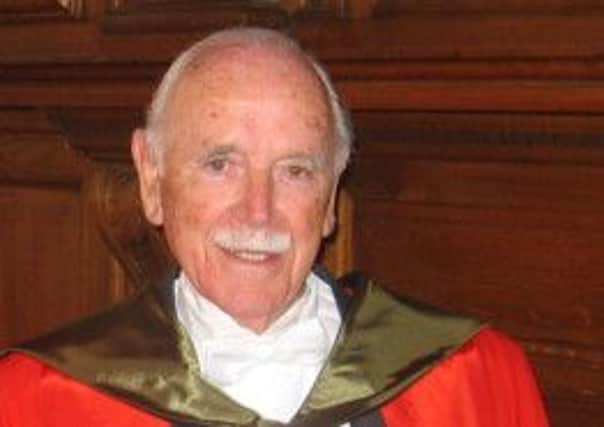Obituary: Dr Frank Rushbrook, fire safety expert


Frank Rushbrook became a fireman in 1938 when, as a young ex-photographer who had decided to make firefighting his career, he was posted to the Central Fire Station in Lauriston Place, Edinburgh. Here he gained a solid foundation of experience at a large number of fires.
In December 1941, he was promoted to section leader and given command of a five-pump station in the heart of the industrial and dock areas of Edinburgh, gaining experience in the management of men, and as officer-in-charge at a wide variety of fires.
Advertisement
Hide AdAdvertisement
Hide AdIn 1944, he was selected to attend the first Long Course in Fire Prevention at the NFS College at Brighton – the most comprehensive course available to fire officers in Britain. On return to duty, he was promoted company officer, and given the responsibility of re-organising the Fire Prevention Department for the south-eastern area of Scotland.
In 1948, Rushbrook became fire prevention officer with the Northumberland County Fire Brigade; and three years later attained divisional rank as third oficer of the Leicester City Fire Brigade – an appointment which gave him the opportunity of attending major fires in operational command, and first-hand experience of the higher administration of a Fire Brigade.
In April 1952, came promotion to deputy firemaster of the Lanarkshire County Fire Brigade; and in 1954 appointment as chief fire officer of the County Borough of East Ham, whose area includes the famous “Royal” Group of London Docks.
It was in East Ham, by virtue of his experience in the Royal Docks, that he realised the need for Merchant Navy personnel to receive training in order that they be prepared to tackle shipboard fires and, in 1955, he started short fire courses for this purpose.
During his service in East Ham, Rushbrook personally pioneered the Fire Brigade use of underwater breathing apparatus; and a news story in The Times in 1959 told the following tale: “While a badly listing ship at London Docks yesterday threatened to turn turtle, Chief Officer Frank Rushbrook, of East Ham Fire Brigade, wearing a self-contained frogman’s outfit, dived to the flooded lower deck. By closing eight portholes he enabled the ship, the German motor vessel Vogelsand, 1,262 tons, to be pumped out.”
The firefighters of East Ham Fire Brigade formed the first Underwater Rescue Service in Britain. In 1959, Rushbrook returned to his home town to become assistant firemaster and shortly after he assumed Command of the Edinburgh & South-East of Scotland Fire Brigade (now Lothian & Borders Fire Brigade).
One of his first tasks was to start planning an imaginative fire school for the purpose of training Merchant Navy officers in all aspects of shipboard fires and fire prevention. To this end he designed a “ship on dry land”, incorporating engine room with dummy engines, pumps, and generators; shaft tunnel with water-tight door and vertical escape trunk; galley; saloon; ten cabins; hold with tweendeck; wireless room and bridge.
A full sprinkler and Multi-Spray system was installed by Messrs Mather & Platt of Manchester. The “ship” was provided with a heating system capable of bringing up the ambient temperature to over 90ºF, and a humidifier to produce conditions synonymous with fire.
Advertisement
Hide AdAdvertisement
Hide AdFrom the start real fires and not smoke bombs were used during training as many Merchant Navy officers can confirm when they proudly show their burn scars but he was convinced that only by feeling the heat and breathing the hot gases could students have the type of experience designed to equip them to tackle the real thing.
This school has trained (and continues to train) many thousands of officers from almost every shipping company in the United Kingdom, as well as many overseas countries. It operates on behalf of the British Shipping Federation and is one of the official schools recognised by the Department of Trade and Industry.
Rushbrook had a very distinguished career in the British Fire Service, including becoming president of the Institution of Fire Engineers and culminating, in the 1970 New Year’s Honours List, by being awarded the insignia of Commander of the Order of the British Empire.
On completion of service, in 1970, Rushbrook retired from his Firemaster’s post in order to set up as a fire consultant. Since then he became known widely throughout the world as an authority on all matters pertaining to ship fires.
He appeared as an expert witness in many parts of the world but mainly in the US. He pioneered a new concept of on-board fire training and has personally trained the crews of 14 VLCCs (very large crude carriers), during ocean voyages.
This type of training has also been carried out on oil-related structures including pipelaying and trench digging barges.
He was, for a number of years, consultant to Lloyd’s Register of Shipping and acted in this capacity for a number of shipping companies and shipbuilders.
In addition, he reported upon and worked on ships actually on fire in many parts of the world.
Advertisement
Hide AdAdvertisement
Hide AdAs firemaster, Rushbrook initiated the establishment of the Department of Fire Safety Engineering at the University of Edinburgh, which was founded in 1973.
He took a keen interest in the running of the department and lectured on the Masters programme on the subject of ship fires.
In 1990 Rushbrook invited me to join him and establish the firm International Fire Investigators and Consultants (IFIC).
In 1995 an account of some of the more important ship fire cases in which Rushbrook had been involved was published by Lloyd’s of London Press under the title Ship Fires and the Law Through the Eyes of a Firefighter.
He is survived by his daughter Jean and daughter-in-law Anne. His wife Violet died in 2001 and his son Ian, a well-known financier, died in 2008.
PROFESSOR JIM LYGATE